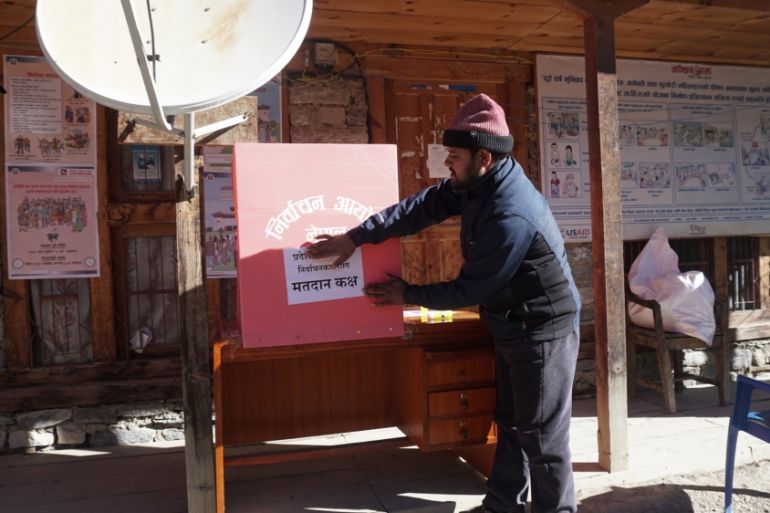Nepal elections explained
Nepalese vote in parliamentary and provincial elections to choose a new government to conclude democratic transition.

Millions of Nepalese are voting in the second phase of the parliamentary and provincial assembly elections, more than a decade after the end of Maoist rebellion.
The elections, which have largely remained peaceful, will hopefully end the Himalayan nation’s long-delayed democratic transition. The first-phase of the election was held on November 26.
Keep reading
list of 4 items‘Absolute power’: After pro-China Maldives leader’s big win, what’s next?
Solomon Islands pro-China PM Manasseh Sogavare fails to secure majority
Pro-China party on course for landslide victory in Maldives election
The new constitution passed in 2015 declared Nepal a federal state with three levels of government: federal, provincial and local.
![Nepal Elections 2017 [Al Jazeera]](/wp-content/uploads/2017/12/87ddd9d0e10745feb01d17771f8d39b8_6.jpeg)
This was intended to decentralise power from Kathmandu to the newly-created seven provinces and local government units.
Voters will elect 275 members to the House of Representatives (HoR) in a mixed system, with 60 percent of representatives chosen through a first-past-the-post (FPTP) system, while the remaining 40 percent will be elected through a Proportional Representation (PR) system.
The federal parliament will be a bicameral legislature, with the 259-member National Assembly (NA) chosen by an electoral college. The HoR and NA will have almost equal powers.
It’s the first parliamentary election since 1999.
Voters will also choose representatives to seven provincial assemblies, for the first time since Nepal turned into a federal republic and abolished the monarchy in 2008.
Counting of votes will begin after the second phase of polling concludes on Thursday. Final results may not be known until the middle of December.
‘Significant achievement’
One-third of the seats have been reserved for women, at all three levels of government. The PR system aims to ensure the representation of Dalits, Janajati (indigenous) groups and minorities in the governing structures.
Anurag Acharya, a political analyst based in Kathmandu, told Al Jazeera it is a “significant achievement” for Nepal, especially after years of instability and a decade-old civil war (1996-2006).
![Nepal Elections 2017 [Al Jazeera]](/wp-content/uploads/2017/12/6d69e783b34844f3847ed5f8f4b17a6d_6.jpeg)
People in the southern region, or Tarai, complain of historical underrepresentation of their communities. They say the boundaries of the new states have been drawn to favour the people from the hills, who have traditionally dominated Nepal’s politics.
Politicians from the southern region say the 2015 constitution has diluted many of the progressive provisions of the 2007 interim constitution.
Acharya says the grievances of marginalised groups such as Madhesis (those living in Tarai) and Tharus need to be addressed.
“The new constitution is an open and flexible document and provides room for future amendment,” Acharya told Al Jazeera.
Despite reservation for women and marginalised groups, politicians have been reluctant in giving tickets to them.
“Women are not being fielded in direct election. It reflects the patriarchal mindset of political class,” Acharya says.
“Similar is the case in regard to Dalits and Janajatis. The marginalised are only getting through the PR list,” he says.
He says, however, that “the process of inclusive political leadership has started from the local elections” which were conducted in three phases between May and September this year.
![Nepal elections 2017 [Al Jazeera]](/wp-content/uploads/2017/12/b477306ddf3c4a47bd03c28d4adaa1a2_6.jpeg)
How does the voting work?
Each voter will be given two ballot papers for the two methods (FPTP and PR). A party has to cross the election threshold of 3 percent of the overall valid vote to be allocated a seat under the PR method.
Forms of government
A multi-party, federal democratic republic and parliamentary form of government will be in effect.
Federal parliament (HoR+NA) will elect a prime minister, who is the real executive head. The leader of the party that wins a simple majority is invited to form the government.
Members of the HoR are elected for a five-year term.
The National Assembly (NA) is a permanent body, with 56 members chosen by an electoral college consisting of PA members and village and municipal executive members. Three members are nominated by the president. It has a term of six years, with one-third of its members retiring every two years on a rotational basis.
The president and vice president are constitutional posts with nominal power. They are elected by an electoral college formed by the HoR, NA and PA members.
The members of the PA choose chief ministers to run the respective provinces.
A total of 753 local units, spread across 77 districts in seven provinces, have been elected to run the village and municipal administration.
The main political parties
- Communist Party of Nepal (Unified Maoist-Leninist)
- Communist Party of Nepal (Maoist Centre)
- Nepali Congress party
- Rastriya Prajatantra Party
- Nepal Sadbhawana Party
- Rastriya Janata Party-Nepal
- Sanghiya Samajbadi Forum (The Federal Socialist Forum)
- Naya Shakti Party (New Force Party)